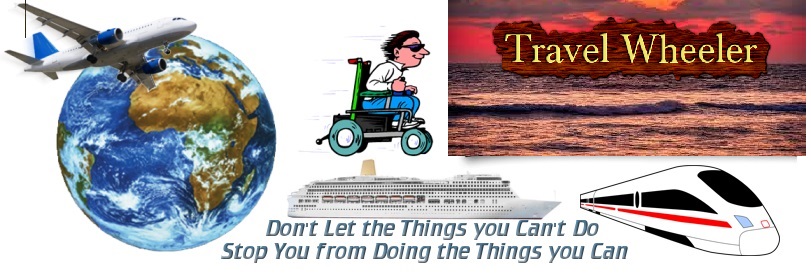
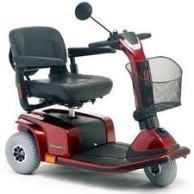
Mobility Devices
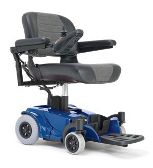
So what is the best mobility device to travel with?
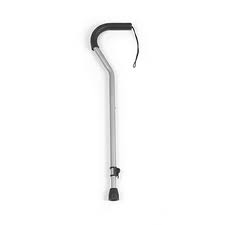
Walking cane
Suitable if you mobility disability is relatively minor, and just need something to help balance you, but are able with a cane to walk to get most places.

Walker
May provide better stability than just a cane, may have a basket and have a place to sit when you get tired.
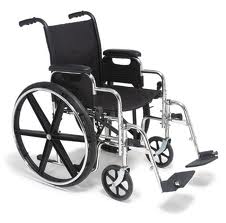
Standard Manual Wheelchair
If it has the big wheel in the back, you can move yourself or be pushed. Moving yourself in terms of endurance will depend on your arm strength. Is hard on the person pushing you for a long time. May be more difficult on inclines.

Scooter
Allows you to get around independently without help from another. Can go up inclines within the recommended angles for you device.

Power Wheelchair
Allows you to get around independently without help from another. Can go up inclines within the recommended angles for you device.
You need to carefully consider what would be best for you taking in consideration how minor or severe your mobility disability is.
Considerations…
- What works for you in the home or in the workplace may not be the best when traveling. You have to consider how far can you walk without stopping with one mobility device and what more could you do if you used something different.
- If your trip includes a cruise, even though cruise ships are built with stability in mind, it should be noted that when a ship is in motion on a ship even in calm seas, there will always be some movement in the ship, it will be worse if the seas are stronger therefore what is suitable on land my be more difficult on a ship in motion.
- How far can you go on your own with each of the mobility devices above.
- What kind of vehicle do you need to bring each of the mobility devices above. Walking cane / Walker (foldable) / and manual foldable wheelchair should fit in any vehicle, assuming you are capable of transferring into the vehicle itself. Power Mobility devices (scooters and power wheelchairs) that are specifically designed for travel purposes that comes apart quickly and easily will often fit in the trunk of most vehicles thereby avoiding the use of wheelchair accessible vehicles as long as you are able to transfer in and out of the vehicle; they will also fit in a bus if the bus has an under floor storage area.
People that cannot walk at all (even a couple of steps) will often have specialized power wheelchairs that are not necessarily designed for travel and does not come apart easily and therefore require wheelchair roll on accessible vehicles for transportation. People that have very limited mobility but yet can walk a few steps using a cane or holding onto something in my belief are better off using a scooter or wheelchair that is designed for travel that will allow them to travel in a greater range of vehicles as the mobility device will come apart and fit in the trunk of most vehicles or under the floor storage area of buses.
In my opinion you have spent money on a trip, why spoil the enjoyment of that trip because your mobility disability makes you unable to walk as far as as fully able bodied person can. Even if you are traveling with a fully able bodied person, how far can they push you in manual wheelchair (even on inclines)? How far can you move yourself in a manual wheelchair in sometimes less than perfect conditions. If you feel you will be restricted in what you can do and how far you can do in manual mobility devices then consider getting a powered mobility device where the tables will be turned around and your able bodied companions will be ones trying to keep up with you.
If you decide on powered mobility, then take these points into consideration…
- Unless your disability requires otherwise, for the purposes of travel, obtain a scooter or wheelchair that is meant and built with travel in mind, and can fold or disassemble quickly without tools. My scooter can come apart in less than a minute into several lighter weight sections. The smaller sections could make the difference between going on a tender boat (ships that cannot dock on shore and transport people at that port by small boats called tenders) or staying on the ship. It also means that you may be able to use transportation other than wheelchair accessible vehicles. This may cut tour costs down.
- I paid an additional $ 100 US to upgrade the battery to increase range, consider the specs of the powered mobility device and how much further you can travel if upgrading the battery. Remember if it is rated for 15 miles on a charge, then it is around 7 miles remember you need the other 7 miles to get back, and it is not exact you may go further or shorter depending on weight and terrain.
- 4 wheel scooters does offer more stability but has a slightly larger turning radius. I have a 3 wheel scooter.
- Wheelchairs can pull up directly to a table where a scooter has the steering tiller in front. Scooters will often have seats that can rotate to the side.
- Wheelchairs may have higher bottom to ground clearances than scooters. Wheelchairs may have a very tight turning radius where scooter may require a 3 point turn in small spaces to turn. In elevators if other people are in the elevator you can always have someone push the desired floor button, and then back out; if alone you can try and get the button as you enter / reach in back of you or do a 3 or 4 point turn in a full size elevator, where a lot of wheelchairs can turn practically on a dime.
- Pick a model that has the weight carrying capabilities higher than your actual weight, if you weight 170 pounds then get one rather for 275 pounds. If you weight 210 pounds get one with a 300 pound rating. Not only it will handle you if you gain a few pounds but may actually go further on a charge and may handle rougher terrain.
Some people with mobility disabilities have two powered devices, one for home and streets and area around home, and one for travel.
Pointers in regards to using scooters and powered wheelchairs…
- Some scooters sits low to the ground, so it is best with low clearance scooters to get some speed up when approaching road edges to sidewalks or ramp edges so even if the anti tip wheel tip hit or the underside hits you have the speed to easily get past it without getting hung up.
- A lot of mobility devices that are designed for travel portability have absolutely no shock adsorption capabilities, however the max. speed of most is 4 to 5 miles per hour and allows you the max portability in traveling.
- Know your scooter or powered wheelchair and it is always best to try it out some before any trip. Read up on your unit. For example when I was in Las Vegas I tried to take a ramp that turned out to be too steep for the scooter, it was actually a moving belt incline but the belt was stopped, when I got about 2/3 the way up the scooter stopped, 2 people at the top came running and we released the motor drive and they pushed me the rest of the way up. It tool us a few minutes to realize what had happened; a circuit breaker on the front of the battery had tripped; if I had known that all I had to do is turn the key off and reached down and reset the breaker and then I could have had a controlled backup to the bottom of the ramp. I guess I should have paid attention to the sign pointing to the elevator wheelchair entrance.
- People jam… There ceases to amaze me the things that able bodied people do. Powered mobility devices do not stop on a dime, the braking system is automatic when you let go on the throttle, but depending on your speed it can take a few feet to stop, and you have to watch out for children that change direction quickly, even adults do not pay attention where they are going; of course they will never think it is there fault if you run into them. Resist the urge after the 3rd person has bumped into you from behind to put it in full reverse.
On the cruise ship I have had a lady with a baby trying to get between the scooter and wall with 1 foot of space when they had several feet of space on the other side or they could have just waited a few seconds and I would have been out of the way.
- hit ramps directly on and not at angles, even more important with 3 wheel scooters. I have tipped over my travel scooter approaching a sidewalk on ramp in Manta, Ecuador that was uneven, travel scooters are lighter than full blown powered wheelchairs and it is a trade off between stability and versatility when traveling. So always survey visually the terrain and pick the best approach to angles and it can help to have an able bodied person in back / side to help stabilize you in certain angle handling. Be careful on public transit, G forces could tip you on turns, some transit systems tie the mobility device down others do not.
- Travel scooters are often not equipped with lights, and in dark areas it would help if you have some kind of light in the front, consider buying a flashlight or battery operated bicycle light that you can mount in the front, unless your scooter came with a built in light, do not tap into the power of the scooter battery. Use of lighting that came with the scooter (if one did come with it) will reduce overall travel distance as the light is consuming some of the battery charge so sometimes it still may be better to use a portable separate battery operated light that does not draw power from the mobility device battery itself.
- do not attempt inclines greater than that recommended by the manufacturer.
- I would recommend charging you mobility device every night if you intend on touring around each day, always better to have a fully charged battery then to find yourself losing power because you ended up going further than expected. If you are on a cruise ship you should be ok for 2 or 3 days as long as you are not leaving the ship, but make certain that you have a fully charged battery if going to shore.
There are also accessories that you can get for scooters and wheelchairs such as cup holders, cane holders / holders for walkers / baskets / oxygen tank holders and so on.
Make sure the type of mobility aids or devices you decide on will allow you to go to most anywhere you wish to go.
By: Donald Kerr